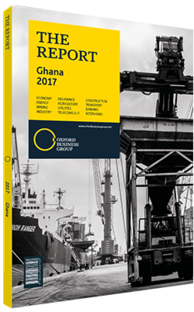Modernisation of small-scale mining in Ghana provides opportunites for sector growth
Following a lengthy process that included various stakeholder consultations and independent reviews, Ghana adopted a Minerals and Mining Policy in February 2016. The policy provides a comprehensive framework for sector governance, seeking to ensure it works as a catalyst for economic growth and contributes to sustainable development.
A key component of this policy is the modernisation of SSM, which aims to stimulate employment and investment opportunities while increasing government revenues. It is hoped the legislation can catalyse an already dynamic segment. “SSM regularly creates over 1m jobs for Ghanaians. As a value-added sub-sector, it is a tremendous driver of growth,” George Abradu-Otoo, managing director and CEO of Precious Minerals Marketing Company, told OBG.
Government Goals
The policy document includes a varied set of objectives and guiding principles, ranging from the sector’s diversification and development of related local industries to the modernisation of artisanal mining and SSM, institutional collaboration on mineral management, tax collection and distribution optimisation, human capital and infrastructure investment, as well as environmental and regional aspects.
The government is hoping that sector regulation will bring an increase in mining tax revenue, as illegal miners register and join the formal sector. According to local reports, Ghana loses an estimated GHS500m ($129m) each year in royalties and taxes to unlicensed, artisanal and small-scale miners.
Modernising Ssm
The modernisation of artisanal and SSM is a central feature of this policy. The government is hoping that its development can not only generate employment and investment opportunities in mining, thereby providing a new source of fiscal revenue for the government, but also address the proliferation of illegal mining, which is currently one of the major issues dogging the sector.
Overall, the document outlines a framework for the provision of technical and financial assistance, incentivising artisanal and small-scale miners to join the formal sector, register and organise into cooperatives, and adopt environmentally-friendly practices. While there are no official figures, available estimates suggest some 200,000 people are directly involved in gold and diamond mining at this level. The majority are illegal miners, also known as galamsey, often leading one-man or relatively small group operations, some of which are said to collaborate illegally with foreign miners on the ground and operate with heavy extraction equipment, in breach of regulations.
MEDIUM-
Scale Mining
n March 2016, the Minerals Commission moved further forward in the effort to modernise mining, announcing the reclassification of SSM into three categories: artisanal, small-scale and medium-scale mining.
In this context, the second category of mining, still reserved for locals, is set to allow the usage of heavy equipment, whereas the third is designed to grant locals the opportunity of establishing partnerships with foreigners by means of joint ventures wherein Ghanaians would hold 60% ownership.
Under the policy, small- and medium-scale mining is allowed in land sizes of up to 25.2 and 50.4 acres, respectively. Medium-scale mining would be subject to a 10-year licence on the condition of providing a business plan or limited feasibility report and the posting of a reclamation bond.
Registration Campaign
At the time of writing, progress was slowly starting to show on illegal miner registration efforts. Critically, the government has reached an agreement with illegal miners occupying AngloGold Ashanti’s Obuasi mining site to transfer them to another exploration area. If solved, this could lead towards a normalisation of the situation on the ground and, ultimately, lead to progress on the
You have reached the limit of premium articles you can view for free.
Choose from the options below to purchase print or digital editions of our Reports. You can also purchase a website subscription giving you unlimited access to all of our Reports online for 12 months.
If you have already purchased this Report or have a website subscription, please login to continue.

